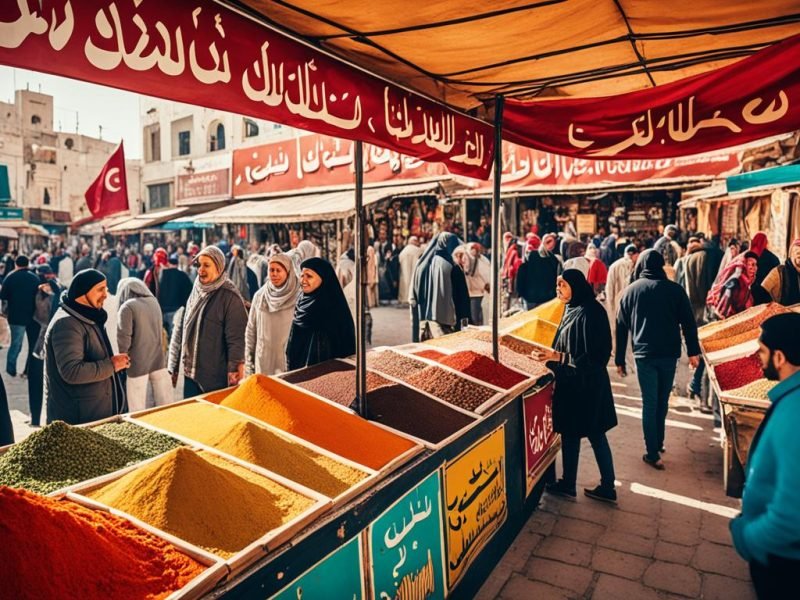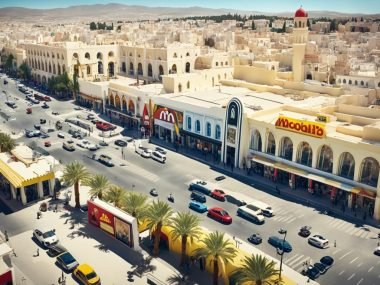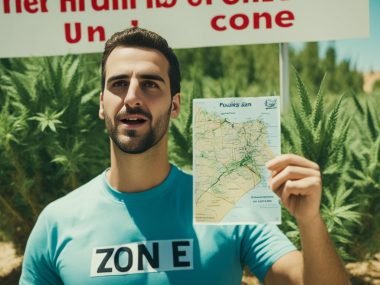Wandering through the medina’s cobblestone streets, I am wrapped in Tunisia’s culture. The scent of jasmine, the colourful market stalls, and the sounds of Arabic show Tunisia’s heart. Arabic here is more than just words. It shows the nation’s identity and brings people together. Asking “Do Tunisia speak Arabic?” goes beyond language. It’s about understanding the Tunisian spirit.
In Tunisia, every word and talk shows the country’s history and daily life. It connects me to Tunisia’s ancient rhythms, even as a visitor.
From markets to cafes, Arabic is key in Tunisian life. My travels here have shown me Arabic is alive and telling Tunisia’s story. This language, rich in tradition, evolves and shares the tales of its people.
Key Takeaways
- Tunisia recognises Arabic as its official language, reflecting the nation’s rich linguistic heritage.
- The Tunisian Constitution underscores the importance of the Arabic language in everyday life.
- Modern Standard Arabic features prominently in Tunisia’s education system and contributes to a literate society.
- French also maintains a significant presence in Tunisia, highlighting the country’s linguistic diversity and history.
- Tunisian Arabic, or ‘Tūnsi’, showcases its unique qualities through mutual intelligibility with other Maghrebi Arabic dialects.
- The intricate relationship between the Tunisian language and Tunisian culture is expressed through daily vernacular and social practices.
Introduction to the Linguistic Landscape of Tunisia
When I think about linguistic diversity in Tunisia, I’m amazed by the mix of languages. This richness comes not only from the different languages spoken. It also comes from the cultural influences on Tunisia’s language. Exploring the languages of Tunisian society feels like travelling through history and culture.
Modern Standard Arabic plays a key role in Tunisia, especially in government and schools. However, Tunisian Arabic, filled with local touches, is heard everywhere. In markets, cafés, and homes, it reflects Tunisian spirit and identity.
There are also languages like Judeo-Tunisian Arabic and Berber dialects. Each one is important to Tunisia’s identity. They tell the stories of Tunisia’s heritage.
Many Tunisians can easily use languages like French, German, English, and Italian. This shows Tunisia as a meeting place of different cultures. It’s where old meets new, creating a unique blend.
Tunisian Sign Language makes sure everyone can communicate. And different keyboard layouts, like AZERTY for French, show how Tunisia adapts to technology.
The way cultural influences on Tunisia’s language show up in daily tech is remarkable. It keeps Tunisians connected to their roots while moving forward.
Linguistic diversity in Tunisia is more than just talking. It celebrates identity, connects the past with the present, and shows the adaptability of Tunisians.
The Linguistic Diversity of Tunisia
Exploring Tunisia’s language reveals a rich heritage. Tunisian Arabic, or ‘Tūnsi’, is more than just speech. It’s a historical blend, drawing from Phoenician, African Romance, and Neo-Punic roots. This mix showcases the country’s colourful past.
In Tunisia, languages from across North Africa blend beautifully. The sound of Maghrebi Arabic fills the air, from busy streets to quiet corners. It shows Tunisia’s unique position in the Arabic-speaking world.
Tunisian Arabic: A Melting Pot of Languages
Tunisian Arabic is fascinating due to its complex past. It includes Phoenician history and hints of African Romance. This mixture highlights the Mediterranean’s rich history. Modern influences from French, Italian, and English also play a part. Thus, making Tunisia a meeting point of cultures.
From Pre-Hilalian to Urban Dialects
The Banu Hilal tribe’s arrival in the 11th century left a significant mark. It introduced new elements and preserved Pre-Hilalian dialects. Today, these dialects still show Berber influence, keeping Tunisia’s original spirit alive.
City dialects in Tunisia are constantly changing. They mix Berber structures, Neo-Punic heritage, and Andalusian words. This blend reflects the diversity of those who have made Tunisia their home.
Berber Languages: The Echoes of An Ancient Tongue
In southern Tunisia, Berber languages like Chenini-Douiret and Matmata-Tamezret thrive. Djerba Berber, too, is spoken in places like Guellala. These languages are ancient voices, connecting Tunisia’s present to its past.
Reflecting on Tunisia’s languages resembles looking at its textiles. Each thread represents a different influence – Phoenician, African, or Neo-Punic. Together, they weave a vivid story of the nation’s journey.
| Language | Region | Characteristics | Current Influence |
|---|---|---|---|
| Tunisian Arabic | Throughout Tunisia | Melting pot with Phoenician, African Romance, and Neo-Punic influence | Primary vernacular |
| Pre-Hilalian Dialects | Rural and Southern Tunisia | Combination of Berber structures with Arabic lexicon | Preserved in rural communities |
| Urban Tunisian Dialects | Urban Centres | Diverse, incorporating Berber, Neo-Punic, and Andalusian elements | Dominant in cities, blending with modern influences |
| Chenini-Douiret Language | Villages of Chenini, Douiret | South Tunisian Berber language variant | Cultural identity marker |
| Matmata-Tamezret Language | Villages of Matmata, Tamezret | Distinct Berber language variant | Reflective of Berber heritage |
| Djerba Berber | Djerba Island | Unique Berber dialect, particularly in Guellala | Integral to regional cultural identity |
Tunisian Arabic – Heart of Tunisia’s Language
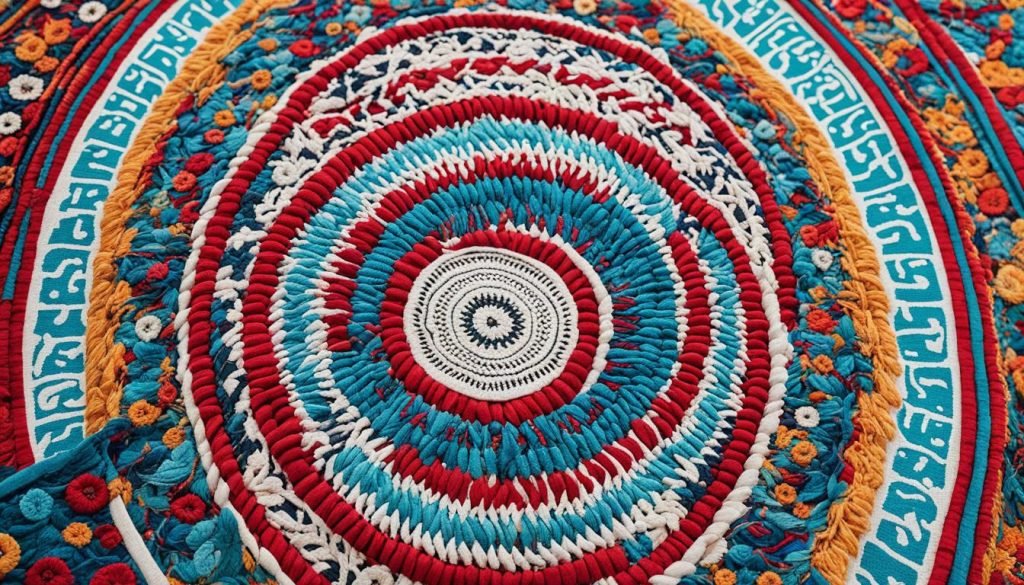
I’ve spent a lot of time studying languages. The Tunisian dialect really stands out to me. It’s a key part of how people in Tunisia connect. Not only is it used every day, but it also shows how the Arabic language shapes Tunisian identity.
The Tunisian dialect is written using the Arabic script. This makes its way into books and online, showing off Tunisia’s culture. The dialect is also part of Tunisian Sign Language. This shows how important it is for everyone to understand each other.
The dialect is a mix, combining local words with ones from other languages. This blend tells the story of Tunisia’s rich history. It shows how the Tunisian way of speaking has evolved. It’s truly Tunisian but still open to outside influences.
| Feature | Relevance to Tunisian Society |
|---|---|
| Use of Arabic Script | Preserves historical and cultural integrity, serves as a bridge between generations. |
| Incorporation in Tunisian Sign Language | Enhances communicative inclusivity and supports the deaf community. |
| Multilingual Loanwords | An embodiment of Tunisia’s rich cultural tapestry and open-mindedness. |
| Badge of National Pride | Cements the Tunisian dialect as a core component of national identity. |
The Tunisian dialect shows the spirit of Tunisia. It stands at the crossroads of old and new. This is a powerful reflection of who Tunisians are.
Tunisian Culture and the Arabic Language
Arabic is not just a way to talk in Tunisia; it deeply colors Tunisian culture with history and tradition. This language keeps Tunisian traditions alive and strengthens the Maghrebi identity, which is unique yet part of a larger Arab story. In exploring this vibrant culture, I’ve seen where language and tradition meet. This gives Tunisians a special society voice among different beliefs, ways of expressing themselves, and everyday life.
Arabic’s Influence on Tunisian Traditions
Over time, Arabic has become woven into Tunisian traditions. It’s now essential for national celebrations, customary rites, and the rich tapestry of Tunisian folklore. It helps pass down wisdom across generations. Every saying and proverb adds to the Tunisian identity story. The mix of languages in Tunisia enriches its culture, blending modernity with ancient heritage through Arabic.
Interplay Between Language and Tunisian Identity
Arabic plays a key role in Tunisian cultural Arabization. It’s a big part of the country’s psyche, shaping Tunisian identity in rural areas and Tunis city. The mix of Maghrebi Arabic with Berber dialects creates a complex linguistic picture. This picture captures the nation’s history and its hopes for a future that includes all languages.
Finally, exploring Tunisia’s culture and language showed me a beautiful symbiosis. It’s a dance of language and tradition that connects Tunisian identity with its Arab roots. This dynamic blend embeds language in the social fabric, making it central to national heritage and unity.
Historical Development of Arabic in Tunisia
The history of Arabic in Tunisia is linked to big events like the Arab conquest of the Maghreb. The rise of Ifriqiya brought changes. Classical Arabic became the language of power, culture, and trade.
The Banu Hilal migration in the 11th century changed Tunisia’s language a lot. It brought new dialects and merged Arab Bedouin customs with local ones. This shaped the historic languages of Tunisia and led to the Hilalian Arabic dialects known today.
I love studying how Ifriqiya, an early Islamic hub in North Africa, spread Arabic across the Maghreb. Different dialects came with the arrivals and departures of various people. This created a unique cultural and linguistic identity in the Maghreb’s coastal cities.
But the story of Arabic in Tunisia didn’t stop with the Banu Hilal migration. Later, Ottoman and European colonial influences brought new words. They expanded and refined Arabic in Tunisia. This blend of cultures and languages shows the rich history of Tunisian identity.
Modern Standard Arabic and Tunisian Dialect
In Tunisia, people use Modern Standard Arabic widely, alongside unique local dialects. This mix shows the country’s love for its culture and its focus on quality education. In schools, the language is key for sharing ideas and growing knowledge.
Education System’s Role in Promoting Modern Standard Arabic
Modern Standard Arabic is vital in Tunisian schools. It teaches students not just how to read and write but also about their culture. This form of Arabic is essential for academic success and for talking about important ideas in the Arab world.
Dialectal Variations: From Coastal Regions to the Sahara
I’ve seen that outside school, Tunisia’s dialects show its cultural variety. You can hear Maghrebi Arabic by the Mediterranean and different languages in the Sahara. Each dialect tells part of Tunisia’s rich history and current culture.
| Region | Dialect | Characteristics |
|---|---|---|
| Coastal Regions | Tunisian Coastal Dialect | Influences from Italian and French, softer pronunciation |
| Urban Centres | Tunisian Urban Dialect | Mixture of linguistic elements from historical migrations |
| Sahara | Saharan Tunisian Dialect | Greater use of Berber loanwords, distinct phonology |
Tunisia’s Bilingual Reality: Arabic and French
Tunisia’s blend of languages tells a story of history and culture. Its bilingual nature shows how its colonial past still shapes today. In this section, I look into how relevant French is in Tunisia today, and its social and economic effects.
Contemporary Usage of French in Tunisian Contexts
In Tunisia’s cities, Arabic and French mix beautifully. French is key in business and intellectual circles, a reminder of past French rule. It’s heard in universities and business meetings, marking it as a language of status. In science and medicine, French terms are crucial, linking Tunisia with the global community.
Arabic and French: A Socioeconomic Perspective
Bilingualism in Tunisia isn’t just about language skills. It affects social and economic standings. Knowing French can lead to better jobs and reflects one’s education. Among the elite, French is a social tool yet also sets people apart. Arabic, though, stays at the heart of Tunisia’s cultural identity.
Arabic and French mix in every aspect of life in Tunisia. This blend enhances lives but also creates a social ladder based on language skills. Tunisia’s European ties, through media and tourism, keep French alive and well in society.
Code-Switching: Blending Arabic with Other Languages
In Tunisia, many people mix Arabic with French and English. This mixing, known as code-switching in Tunisia, is common both inside the country and among Tunisians worldwide.
I’ve noticed that in Tunisia, being multilingual is more than knowing many languages. It’s part of the culture. People might start talking in one language and then switch to another. This happens a lot among those who are well-educated.
This skill shows how Tunisians adapt to blending their rich history with new global influences. Code-switching is not just for talking; it’s a key part of their identity. It connects them to the wider world.
| Context | Language Used | Purpose of Code-Switching |
|---|---|---|
| Educational Settings | Modern Standard Arabic, French, English | To elucidate complex concepts and connect with international academia |
| Business Meetings | French, English, Tunisian Arabic | For commercial negotiations and international trade discussions |
| Social Gatherings | Tunisian Arabic, French, English | To include members of different linguistic backgrounds |
Looking at the table, it’s clear how code-switching aligns communication with the situation. The Tunisian diaspora especially reflects this flexibility. They weave their global experiences into everyday language. Multilingualism and code-switching enhance Tunisia’s cultural depth. They showcase a society that’s rooted yet boldly international.
The Influence of the Media and Tourism on Tunisian Arabic
In Tunisia’s markets and landscapes, language captures the nation’s heart. It is steeped in tradition yet adaptable. Looking at Tunisian media and tourism in Tunisia shows language changes. It highlights language’s dynamic evolution.
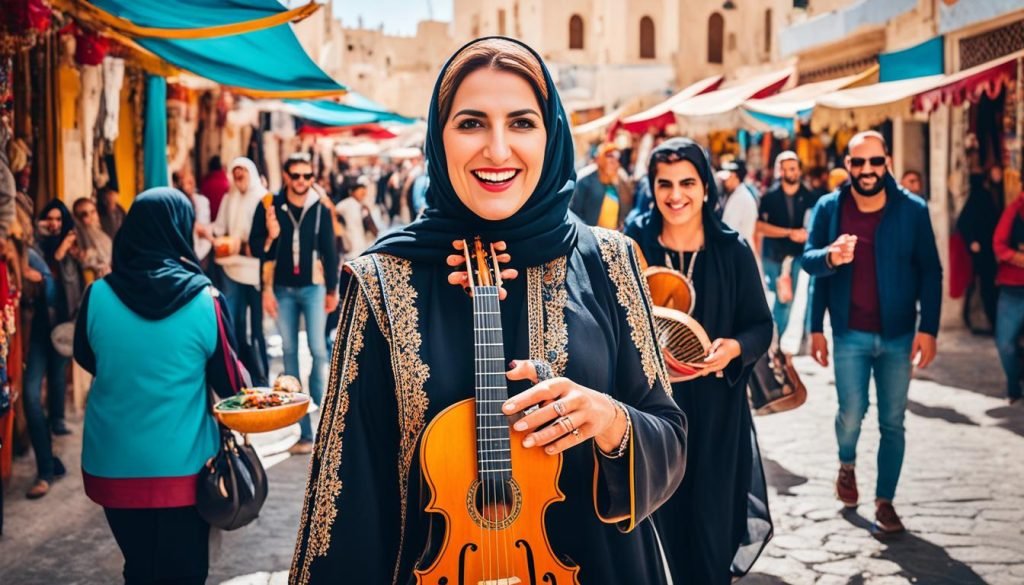
Media’s Role in the Evolution of Tunisian Arabic
In Tunisia, as people watch TV or browse their phones, they see language changing. Tunisian media brings new words and phrases into daily use. TV shows, news, and online content share cultures and change language.
Media offers info and shifts how locals speak. It ensures linguistic adaptation in Tunisia mirrors social changes.
Tourism and Language Adaptation in Tunisia
Visitors to Tunisia bring words from around the world. The beauty of Tourism in Tunisia attracts these guests. They exchange languages with locals. This mix enriches Tunisian Arabic.
This back and forth shows Tunisia’s welcoming culture. It keeps communication growing and changing.
Conclusion
Tunisia’s language history shows a strong and changing linguistic heritage. Arabic roots provide the base, influenced by history and world flows. French adds to the nation’s unique voice, with English and Italian also joining the mix.
Tunisians are skilled in languages, showing their culture’s ability to adapt. Code-switching highlights their worldly charm. Media and tourism keep Tunisian Arabic evolving, showing openness to new influences but also a deep respect for tradition.
The mix of languages in Tunisia creates a unique dialogue with the world. This blend of old and new shapes Tunisia’s identity. It allows the country to share its story globally and cherish its people’s tales.

